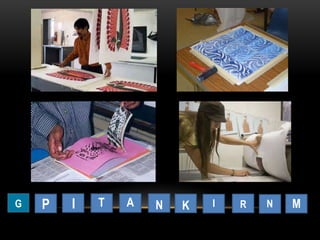Printmaking
- 2. PRINTMAKING
- 3. Printmaking is the process of making artworks by printing, normally on paper. Printmaking normally covers only the process of creating prints with an element of originality, rather than just being a photographic reproduction of a painting.
- 5. RELIEF PRINTING Bas-relief of famous Arch of Galerius in Thessaloniki
- 6. RELIEF PRINTING Relief printing is a printmaking process where protruding surface faces of the matrix (printing plate or block) are inked; recessed areas are ink free. Printing the image is therefore a relatively simple matter of inking the face of the matrix and bringing it in firm contact with the paper. A printing-press may not be needed as the back of the paper can be rubbed or pressed by hand with a simple tool such as a brayer or roller. The matrix in relief printing is classically created by starting with a flat original surface, and then removing (e.g., by carving) away areas intended to print white. The remaining areas of the original surface receive the ink.
- 7. INTAGLIO ... hear; they have very large ears. Intaglio print by Ralph Slatton
- 8. INTAGLIO Intaglio is the family of printing and printmaking techniques in which the image is incised into a surface, and the incised line or sunken area holds the ink. It is the direct opposite of a relief print. Normally, copper or zinc plates are used as a surface or matrix, and the incisions are created by etching, engraving, drypoint, aquatint or mezzotint. Collagraphs may also be printed as intaglio plates.
- 9. ETCHED PAINTING The Three Crosses, etc hing by Rembrandt
- 10. ETCHED PRINTING Etching is part of the intaglio family. The process is believed to have been invented by Daniel Hopfer (circa 1470-1536) of Augsburg, Germany, who decorated armour in this way, and applied the method to printmaking. Etching soon came to challenge engraving as the most popular printmaking medium. Its great advantage was that, unlike engraving which requires special skill in metalworking, etching is relatively easy to learn for an artist trained in drawing. Etching prints are generally linear and often contain fine detail and contours. Lines can vary from smooth to sketchy. In pure etching, a metal (usually copper, zinc or steel) plate is covered with a waxy or acrylic ground. The artist then draws through the ground with a pointed etching needle. The exposed metal lines are then etched by dipping the plate in a bath of etchant (e.g. nitric acid or ferric chloride). The etchant "bites" into the exposed metal, leaving behind lines in the plate. The remaining ground is then cleaned off the
- 11. LITHOGRAPHY La Goulue, Lith ograph poster by ToulouseLautrec.
- 12. LITHOGRAPHY Lithography is a technique invented in 1798 by Alois Senefelder and based on the chemical repulsion of oil and water. A porous surface, normally limestone, is used; the image is drawn on the limestone with a greasy medium. Acid is applied, transferring the grease to the limestone, leaving the image 'burned' into the surface. Gum arabic, a water soluble substance, is then applied, sealing the surface of the stone not covered with the drawing medium. The stone is wetted, with water staying only on the surface not covered in greasebased residue of the drawing; the stone is then 'rolled up', meaning oil ink is applied with a roller covering the entire surface; since water repels the oil in the ink, the ink adheres only to the greasy parts, perfectly inking the image. A sheet of dry paper is placed on the surface, and the image is transferred to the paper by the pressure of the printing press. Lithography is known for its ability to capture fine gradations in shading and very small detail. A variant is photolithography, in which the image is captured by photographic processes on metal plates; printing is carried out in the same way.
- 13. SERIGRAPHY OR SCREEN PRINTING
- 14. SERIGRAPHY OR SCREEN PRINTING Screen printing, silkscreen, or serigraphy creates prints by using a fabric stencil technique; ink is simply pushed through the stencil against the surface of the paper, most often with the aid of a squeegee. Generally, the technique uses a natural or synthetic 'mesh' fabric stretched tightly across a rectangular 'frame,' much like a stretched canvas. The fabric can be silk, nylon monofilament, multifilament polyester, or even stainless steel. While commercial screen printing often requires high-tech, mechanical apparatuses and calibrated materials, printmakers value it for the "Do It Yourself" approach, and the low technical requirements, high quality results. The essential tools required are a squeegee, a mesh fabric, a frame, and a stencil. Unlike many other printmaking processes, a printing press is not required, as screen printing is essentially stencil printing. Screen printing may be adapted to printing on a variety of materials, from paper, cloth, and canvas to rubber, glass, and metal. Artists have used the technique to print on bottles, on slabs of granite, directly onto walls, and to reproduce images on textiles which would distort under pressure from printing presses.

